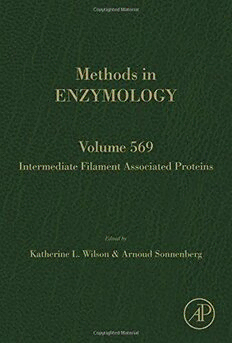
Intermediate filament associated proteins PDF
Preview Intermediate filament associated proteins
METHODS IN ENZYMOLOGY Editors-in-Chief ANNA MARIE PYLE Departments of Molecular, Cellular and Developmental Biology and Department of Chemistry Investigator Howard Hughes Medical Institute Yale University DAVID W. CHRISTIANSON Roy and Diana Vagelos Laboratories Department of Chemistry University of Pennsylvania Philadelphia, PA Founding Editors SIDNEY P. COLOWICK and NATHAN O. KAPLAN AcademicPressisanimprintofElsevier 50HampshireStreet,5thFloor,Cambridge,MA02139,USA 525BStreet,Suite1800,SanDiego,CA92101–4495,USA TheBoulevard,LangfordLane,Kidlington,OxfordOX51GB,UK 125LondonWall,London,EC2Y5AS,UK Firstedition2016 Copyright©2016ElsevierInc.Allrightsreserved. Nopartofthispublicationmaybereproducedortransmittedinanyformorbyanymeans, electronicormechanical,includingphotocopying,recording,oranyinformationstorageand retrievalsystem,withoutpermissioninwritingfromthepublisher.Detailsonhowtoseek permission,furtherinformationaboutthePublisher’spermissionspoliciesandour arrangementswithorganizationssuchastheCopyrightClearanceCenterandtheCopyright LicensingAgency,canbefoundatourwebsite:www.elsevier.com/permissions. Thisbookandtheindividualcontributionscontainedinitareprotectedundercopyrightby thePublisher(otherthanasmaybenotedherein). Notices Knowledgeandbestpracticeinthisfieldareconstantlychanging.Asnewresearchand experiencebroadenourunderstanding,changesinresearchmethods,professionalpractices, ormedicaltreatmentmaybecomenecessary. Practitionersandresearchersmustalwaysrelyontheirownexperienceandknowledgein evaluatingandusinganyinformation,methods,compounds,orexperimentsdescribed herein.Inusingsuchinformationormethodstheyshouldbemindfuloftheirownsafetyand thesafetyofothers,includingpartiesforwhomtheyhaveaprofessionalresponsibility. Tothefullestextentofthelaw,neitherthePublishernortheauthors,contributors,oreditors, assumeanyliabilityforanyinjuryand/ordamagetopersonsorpropertyasamatterof productsliability,negligenceorotherwise,orfromanyuseoroperationofanymethods, products,instructions,orideascontainedinthematerialherein. ISBN:978-0-12-803469-9 ISSN:0076-6879 ForinformationonallAcademicPresspublications visitourwebsiteathttp://store.elsevier.com/ CONTRIBUTORS NoeliaAlonso-Garc´ıa InstitutodeBiolog´ıaMolecularyCelulardelCa´ncer,ConsejoSuperiordeInvestigaciones Cient´ıficas,UniversityofSalamanca,Salamanca,Spain RuthellenH.Anderson SanfordChildren’sHealthResearchCenter,SanfordResearch,SiouxFalls,SouthDakota, USA ChristopherArnette DepartmentofPathology,NorthwesternUniversityFeinbergSchoolofMedicine,Chicago, Illinois,USA PeterAskjaer AndalusianCenterforDevelopmentalBiology,CSIC-JuntadeAndalucia-Universidad PablodeOlavide,CarreteradeUtrera,Seville,Spain PetrosBatsios InstituteforBiochemistryandBiology,DepartmentofCellBiology,UniversityofPotsdam, Potsdam,Germany NadjaBegre´ DepartmentofClinicalResearch,UniversityofBern,andDepartmentofDermatology, Inselspital,BernUniversityHospital,Bern,Switzerland JasonM.Berk DepartmentofCellBiology,JohnsHopkinsUniversitySchoolofMedicine,Baltimore, Maryland,USA VeronikaBoczonadi InstituteofGeneticMedicine,NewcastleUniversity,Newcastle-upon-Tyne,United Kingdom PascaleBomont Atip-AvenirTeam,andINMInsermU1051,Universite´ deMontpellier,Montpellier, France LucaBorradori DepartmentofClinicalResearch,UniversityofBern,andDepartmentofDermatology, Inselspital,BernUniversityHospital,Bern,Switzerland Jamal-EddineBouameur DepartmentofClinicalResearch,UniversityofBern,andDepartmentofDermatology, Inselspital,BernUniversityHospital,Bern,Switzerland BenjaminBourgeois InstituteforIntegrativeBiologyoftheCell,CEA,CNRS,Universite´ Paris-Sud, Gif-sur-Yvette,Paris,France xiii xiv Contributors BrigitteBuendia InstitutdeBiologieFonctionnelleetAdaptative,Universite´ ParisDiderot,Paris,France Rube´nM.Buey InstitutodeBiolog´ıaMolecularyCelulardelCa´ncer,ConsejoSuperiordeInvestigaciones Cient´ıficas,andMetabolicEngineeringGroup,DepartmentofMicrobiologyandGenetics, UniversityofSalamanca,Salamanca,Spain ArturoCarabias InstitutodeBiolog´ıaMolecularyCelulardelCa´ncer,ConsejoSuperiordeInvestigaciones Cient´ıficas,UniversityofSalamanca,Salamanca,Spain AnaM.Carballido InstitutodeBiolog´ıaMolecularyCelulardelCa´ncer,ConsejoSuperiordeInvestigaciones Cient´ıficas,UniversityofSalamanca,Salamanca,Spain Hee-JungChoi SchoolofBiologicalSciences,SeoulNationalUniversity,Seoul,SouthKorea DonaldM.Coen DepartmentofBiologicalChemistryandMolecularPharmacology,HarvardMedical School,Boston,Massachusetts,USA VictorE.Cruz DepartmentofBiology,MassachusettsInstituteofTechnology,Cambridge,Massachusetts, USA Jose´ M.dePereda InstitutodeBiolog´ıaMolecularyCelulardelCa´ncer,ConsejoSuperiordeInvestigaciones Cient´ıficas,UniversityofSalamanca,Salamanca,Spain AgnieszkaDobrzynska AndalusianCenterforDevelopmentalBiology,CSIC-JuntadeAndalucia-Universidad PablodeOlavide,CarreteradeUtrera,Seville,Spain F.EsraDemircioglu DepartmentofBiology,MassachusettsInstituteofTechnology,Cambridge,Massachusetts, USA BertrandFavre DepartmentofClinicalResearch,UniversityofBern,andDepartmentofDermatology, Inselspital,BernUniversityHospital,Bern,Switzerland RicardoA.Figueroa DepartmentofNeurochemistry,StockholmUniversity,Stockholm,Sweden RadiaForteza DepartmentofCellBiology,UniversityofMiamiMillerSchoolofMedicine,Miami, Florida,USA PeterFuchs DepartmentofBiochemistryandCellBiology,MaxF.PerutzLaboratories,Universityof Vienna,ViennaBiocenter(VBC),Vienna,Austria Contributors xv ChristelleGally IGBMC,DevelopmentandStemCellsProgram,CNRS(UMR7104)/INSERM(U964)/ Universite´ deStrasbourg,Illkirch,France SpiroGetsios DepartmentofDermatology;DepartmentofCellandMolecularBiology,Northwestern UniversityFeinbergSchoolofMedicine,andRobertH.LurieComprehensiveCancer Center,NorthwesternUniversity,Chicago,Illinois,USA Mar´ıaGo´mez-Herna´ndez InstitutodeBiolog´ıaMolecularyCelulardelCa´ncer,ConsejoSuperiordeInvestigaciones Cient´ıficas,UniversityofSalamanca,Salamanca,Spain DmitryGoryunov DepartmentofPathologyandCellBiology,TaubInstituteforResearchonAlzheimer’s DiseaseandtheAgingBrain,ColumbiaUniversityCollegeofPhysiciansandSurgeons, NewYork,USA KathleenJ.Green DepartmentofPathology;DepartmentofDermatology,NorthwesternUniversityFeinberg SchoolofMedicine,andRobertH.LurieComprehensiveCancerCenter,Northwestern University,Chicago,Illinois,USA RalphGra¨f InstituteforBiochemistryandBiology,DepartmentofCellBiology,UniversityofPotsdam, Potsdam,Germany YosefGruenbaum DepartmentofGenetics,TheAlexanderSilbermanInstituteofLifeSciences,TheHebrew UniversityofJerusalem,Jerusalem,Israel InesHahn FacultyofLifeSciences,MichaelSmithBuilding,Manchester,UnitedKingdom EinarHallberg DepartmentofNeurochemistry,StockholmUniversity,Stockholm,Sweden JenniferC.Harr DepartmentofBiologicalChemistryandCenterforEpigenetics,JohnsHopkinsUniversity, Baltimore,MD,USA IsalineHerrada InstituteforIntegrativeBiologyoftheCell,CEA,CNRS,Universite´ Paris-Sud, Gif-sur-Yvette,Paris,France PaulHoover DepartmentofDermatology,NorthwesternUniversityFeinbergSchoolofMedicine, Chicago,Illinois,USA Yu-ShanHuang InstituteofMolecularMedicine,CollegeofLifeSciences,NationalTsingHuaUniversity, Hsinchu,Taiwan xvi Contributors ArantzaInfante StemCellsandCellTherapyLaboratory,BioCrucesHealthResearchInstitute,Cruces UniversityHospital,Barakaldo,Spain MohammedHakimJafferali DepartmentofNeurochemistry,StockholmUniversity,Stockholm,Sweden JeremyP.Kamil DepartmentofBiologicalChemistryandMolecularPharmacology,HarvardMedical School,Boston,Massachusetts,andDepartmentofMicrobiologyandImmunology, LouisianaStateUniversityHealthSciencesCenter,Shreveport,Louisiana,USA JenniferL.Koetsier DepartmentofPathology,NorthwesternUniversityFeinbergSchoolofMedicine,Chicago, Illinois,USA RashmiKothary RegenerativeMedicineProgram,OttawaHospitalResearchInstitute;Departmentof CellularandMolecularMedicine;DepartmentofMedicine,UniversityofOttawa,and UniversityofOttawaCenterforNeuromuscularDisease,Ottawa,Ontario,Canada MichelLabouesse IBPS,Paris,France RonaldK.H.Liem DepartmentofPathologyandCellBiology,TaubInstituteforResearchonAlzheimer’s DiseaseandtheAgingBrain,ColumbiaUniversityCollegeofPhysiciansandSurgeons, NewYork,USA AnishaLynch-Godrei RegenerativeMedicineProgram,OttawaHospitalResearchInstitute,andDepartmentof CellularandMolecularMedicine,UniversityofOttawa,Ottawa,Ontario,Canada ArtoMa¨a¨tta¨ SchoolofBiologicalandBiomedicalSciences,DurhamUniversity,Durham, UnitedKingdom AlexandrA.Makarov WellcomeTrustCentreforCellBiology,UniversityofEdinburgh,Edinburgh, UnitedKingdom Jose´ A.Manso InstitutodeBiolog´ıaMolecularyCelulardelCa´ncer,ConsejoSuperiordeInvestigaciones Cient´ıficas,UniversityofSalamanca,Salamanca,Spain AnastasiaMashukova DepartmentofPhysiology,NovaSoutheasternUniversity,Ft.Lauderdale,andDepartment ofCellBiology,UniversityofMiamiMillerSchoolofMedicine,Miami,Florida,USA AaronA.Mehus SanfordChildren’sHealthResearchCenter,SanfordResearch,SiouxFalls,SouthDakota, USA Contributors xvii PeterMeinke WellcomeTrustCentreforCellBiology,UniversityofEdinburgh,Edinburgh,United Kingdom IreneMeyer InstituteforBiochemistryandBiology,DepartmentofCellBiology,UniversityofPotsdam, Potsdam,Germany EstherOrtega InstitutodeBiolog´ıaMolecularyCelulardelCa´ncer,ConsejoSuperiordeInvestigaciones Cient´ıficas,UniversityofSalamanca,Salamanca,Spain Ming-DerPerng InstituteofMolecularMedicine,CollegeofLifeSciences,NationalTsingHuaUniversity, Hsinchu,Taiwan AndreasProkop FacultyofLifeSciences,MichaelSmithBuilding,Manchester,UnitedKingdom RoyA.Quinlan BiophysicalSciencesInstitute,UniversityofDurham,Durham,UnitedKingdom KarenL.Reddy DepartmentofBiologicalChemistryandCenterforEpigenetics,JohnsHopkinsUniversity, Baltimore,MD,USA Gu¨ntherA.Rezniczek DepartmentofObstetrics&Gynecology,MarienHospitalHerne,Ruhr-Universita¨t Bochum,Herne,Germany AndreaRizzotto WellcomeTrustCentreforCellBiology,UniversityofEdinburgh,Edinburgh,United Kingdom ClaraI.Rodr´ıguez StemCellsandCellTherapyLaboratory,BioCrucesHealthResearchInstitute,Cruces UniversityHospital,Barakaldo,Spain MatthewRonshaugen FacultyofLifeSciences,MichaelSmithBuilding,Manchester,UnitedKingdom KyleJ.Roux SanfordChildren’sHealthResearchCenter,SanfordResearch,andDepartmentof Pediatrics,SanfordSchoolofMedicine,UniversityofSouthDakota,SiouxFalls, SouthDakota,USA Ine´sGarc´ıaRubio CentroUniversitariodelaDefensa,AcademiaGeneralMilitar,Zaragoza,Spain PedroJ.Salas DepartmentofCellBiology,UniversityofMiamiMillerSchoolofMedicine,Miami, Florida,USA CamilleSamson InstituteforIntegrativeBiologyoftheCell,CEA,CNRS,Universite´ Paris-Sud,Gif-sur- Yvette,Paris,France xviii Contributors EricC.Schirmer WellcomeTrustCentreforCellBiology,UniversityofEdinburgh,Edinburgh,United Kingdom ThomasU.Schwartz DepartmentofBiology,MassachusettsInstituteofTechnology,Cambridge,Massachusetts, USA MayuriSharma DepartmentofBiologicalChemistryandMolecularPharmacology,HarvardMedical School,Boston,Massachusetts,USA NataliaSa´nchez-Soriano CellularandMolecularPhysiology,InstituteofTranslationalMedicine,Universityof Liverpool,Liverpool,UnitedKingdom SandraSzabo DepartmentofBiochemistryandCellBiology,MaxF.PerutzLaboratories,Universityof Vienna,ViennaBiocenter(VBC),Vienna,Austria GernotWalko CentreforStemCells&RegenerativeMedicine,FacultyofLifeSciencesandMedicine, King’sCollegeLondon,London,UnitedKingdom WilliamI.Weis DepartmentofStructuralBiology,andDepartmentofMolecular&CellularPhysiology, StanfordUniversitySchoolofMedicine,Stanford,California,USA KarlL.Wo€genstein DepartmentofBiochemistryandCellBiology,MaxF.PerutzLaboratories,Universityof Vienna,ViennaBiocenter(VBC),Vienna,Austria GerhardWiche DepartmentofBiochemistry&CellBiology,MaxF.PerutzLaboratories,Universityof Vienna,Vienna,Austria KatherineL.Wilson DepartmentofCellBiology,JohnsHopkinsUniversitySchoolofMedicine,Baltimore, Maryland,USA LilliWinter InstituteofNeuropathology,UniversityHospitalErlangen,Erlangen,Germany HowardJ.Worman DepartmentofMedicine,andDepartmentofPathologyandCellBiology,Collegeof PhysiciansandSurgeons,ColumbiaUniversity,NewYork,USA HuiminZhang JiangsuKeyLaboratoryofInfectionandImmunity,InstitutesofBiologyandMedical Sciences,SoochowUniversity,Suzhou,Jiangsu,PRChina SophieZinn-Justin InstituteforIntegrativeBiologyoftheCell,CEA,CNRS,Universite´ Paris-Sud,Gif-sur- Yvette,Paris,France PREFACE Proteins that bind to intermediate filaments come in hundreds of sizes and “flavors.”Somearestructuralgiantsthatinterlinkthecytoskeleton.Others resideattheinnernuclearmembrane,holdingcourtwithlaminsandsilent genes. Many more remain hidden from view, their potential contributions tocellsordiseaseunknown.Studyingsuchproteinsrequiresacutting-edge toolkit of methods and expert advice, both featured in this volume of Methods in Enzymology. Rouxandcolleagues(Chapter1)detailapowerfulandbroadlyapplica- blemethod,biotinylationidentification(BioID),toidentifyproteinslocated within 10nm of a BioID-fusion protein in living cells. These “proximal” proteins include direct in vivo partners or associated protein complexes, as demonstrated for the nuclear intermediate protein, lamin A. Gra¨f and col- leaguessuccessfullymodifiedtheBioIDtoolkitforuseinDictyostelium,now enabling studies of intermediate filament-associated proteins in this evolu- tionarily diverse organism (Chapter 2). Taking “lamin association” to an entirely new level, Harr and Reddy detail their state-of-the-art new TCIS method to study how specific segments of DNA or chromatin-associated proteins drive intranuclear movement to lamins and the nuclear lamina (Chapter 21). Proteins that bind lamins are exceedingly diverse. Schirmer and col- leagues provide insights into the many biochemical and functional features thatshouldbeconsideredwhenexpressinganemergingspectrumoflamin- bindingnuclearmembraneproteinsasrecombinantpolypeptidesinbacteria (Chapter 5). Successful methods for purification and structural analysis are provided for specific lamin-binding proteins. These include SUN-domain and KASH-domain proteins, which form LINC complexes that transduce force across the nuclear envelope (Schwartz and colleagues, Chapter 4), as well as LAP2, emerin and MAN1, which share the eponymous LEM- domainfoldandalsohaveunstructuredregions(Zinn-Justinandcolleagues, Chapter 3). Beyond proteins, Coen and colleagues describe how to purify entire “nuclear egress” complexes formed by the human cytomegalovirus, which include lamin-associated proteins (Chapter 25). Advancesinthepurificationandstructuralanalysisofchallenginglylarge cytoplasmic proteins are provided for plectin and BPAG1e (de Pereda and colleagues, Chapter 10) and desmoplakin (Choi and Weis, Chapter 11). xix xx Preface Functional assays are providing significant insight into the biological roles of cytoplasmic intermediate filament binding proteins, including molecular chaperones (Salas and colleagues, Chapter 8; Quinlan and col- leagues, Chapter 9) and gigaxonin, an E3 ubiquitin ligase involved in the degradation of intermediate filament proteins (Bomont, Chapter 12). Borradori and colleagues describe a new GFP-based binding assay to study plakin association with intermediate filaments (Chapter 7). Green and col- leagues use a 3D culture model to advance the functional interrogation of theintermediatefilament-desmosomescaffoldduringkeratinocytedifferen- tiation (Chapter 15). Boczonadi and Ma¨a¨tta¨ discuss general approaches to study the function of periplakin and envoplakin in cell culture models and gene-targeted mice (Chapter 16). The functional diversity of lamin- associated proteins is reflected in protocols to separate functionally distinct populationsoflamin-bindingproteins(BerkandWilson,Chapter6),iden- tify transcription factors relevant to prelamin A pathology (Infante and Rodr´ıguez, Chapter 23), and identify novel protein–protein interactions atthenuclearenvelopeviachemicalcross-linking(Hallbergandcolleagues, Chapter 24). Geneticmethodsareincreasinglyimportanttounderstandintermediate filamentbiologyandareexpandingbeyondmice.ThisvolumeofMethodsin Enzymologyincludesstate-of-the-artprotocolstostudylamin-bindingpro- teins in Caenorhabditis elegans, which has one lamin gene (Gruenbaum and colleagues, Chapter 22), and to study the complex functions of the single spectraplakin locus in either C. elegans (Labouesse and colleagues, Chapter 20) or Drosophila (Prokop and colleagues, Chapter 19). Other chapters describe increasingly sophisticated use of mouse genetics to study the roles of plectin in skin and muscle (Wiche and colleagues, Chapter 13), epiplakin in epithelial cells (Fuchs and colleagues, Chapter 14), BPAG1 in neurons (Lynch-Godrei and Kothary, Chapter 18), and microtubule-actin cross-linkingfactor1intheskin,heart,nervoussystem,andintestinalepithelia (Goryunov and Liem, Chapter 17). We sincerely hope these protocols will help your research advance. ARNOUD SONNENBERG AND KATHERINE L. WILSON Division of Cell Biology, The Netherlands Cancer Institute, Amsterdam, The Netherlands Department of Biology, The Johns Hopkins University School of Medicine, Baltimore Maryland, USA
